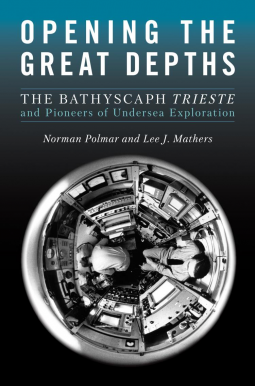
Opening the Great Depths
The Bathyscaph Trieste and Pioneers of Undersea Exploration
by By Norman Polmar and Lee J. Mathers
This title was previously available on NetGalley and is now archived.
Send NetGalley books directly to your Kindle or Kindle app
1
To read on a Kindle or Kindle app, please add kindle@netgalley.com as an approved email address to receive files in your Amazon account. Click here for step-by-step instructions.
2
Also find your Kindle email address within your Amazon account, and enter it here.
Pub Date May 15 2021 | Archive Date Apr 01 2021
Talking about this book? Use #OpeningtheGreatDepths #NetGalley. More hashtag tips!
Description
“We were certainly pioneers as the Trieste was one of only two such vehicles in the world—the French Navy’s bathyscaphe FNRS-3 was the other. It meant that we had to ‘write the book’ about deep submergence operations in terms of technique and technologies. We learned by doing and by failures, although very few of the latter were serious. For example, if we needed a piece of equipment we would have to design it and make it. There were no commercial vendors who catered to deep submergence technology requirements. The market was far too small.” —From the foreword by Capt. Don Walsh, USN (Ret.), PhD, U.S. Navy Submersible Pilot No. 1
Developed by French physicist Auguste Piccard and his son Jacques, the bathyscaph Trieste was a scientific marvel that allowed unprecedented scientific, technical, and military feats in the ocean depths. France and the United States both acquired and subsequently developed variants of the original bathyscaph. While both France and the United States employed the bathyscaph as a tool for scientific investigation of the deepest ocean depths, the U.S. Navy developed and employed the Trieste for military missions as well. From its earliest years, participants in the Trieste program realized that they were making history, blazing a trail into previously unexplored and unexploited depths, developing new capabilities and opening a new frontier. Comparisons with developments in space and the space-race between the United States and the Soviet Union often were made concerning the Trieste program and contemporary developments in undersea technologies and capabilities.
The Trieste opened the entire oceans to exploration, exploitation, and operations. The bathyscaph was a first-generation system, a “Model-T” that spawned an entirely new industry and encouraged new concepts for deep-ocean naval operations. Advances in deep-sea technologies lacked the “gee-whiz” factor of the concurrent space race, but were highly significant in the development of new technology, new knowledge, and new military capabilities.
Opening the Great Depths is the story of the three Trieste deep-ocean vehicles, their officers and enlisted men, and the civilians, often told in their own words, documenting for the first time the earliest years of humanity's probing into Earth's final frontier.
Available Editions
| EDITION | Hardcover |
| ISBN | 9781682475911 |
| PRICE | $44.95 (USD) |



